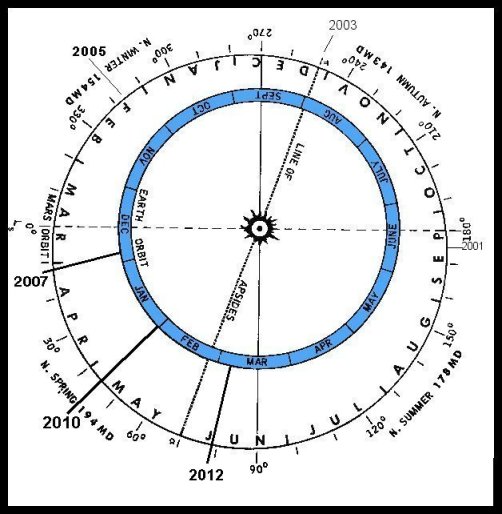
ABSTRACT
Always an intriguing world, Mars offers both casual and serious observers many challenges and delights. It also provides astronomers a laboratory to study the atmosphere and surface of another planet, including the behavior of condensates and their effects on its atmosphere and surface. Mars is similar to Earth in that it has four seasons, exhibits global climates, changing weather patterns, annual thawing and growing of polar caps, storm clouds of water ice, howling dusty winds, and a variety of surface features that predictably change in color and size and appear to shift position over extended periods of time.
Mars appears more Earth-like to us than most of the other planets because we can observe its surface, atmospheric clouds and hazes, and its brilliant white polar caps. The latter are composed of frozen CO2 and underlying water ice, and wax and wane during the Martian year. These aspects, along with the changing seasons and the possibility of life, have made Mars one of the most studied planets in our solar system.
The Red Planet Mars offers both casual and serious observers many challenges and delights, as well as providing astronomers a laboratory to study another planet's atmosphere and surface. Some Martian features even appear to shift position around the surface over extended periods of time.
There are several cooperating international Mars observing programs under way to assist both professional and amateur astronomers. These include the International Mars Patrol (I.M.P.) coordinated by the Mars Section of the Association of Lunar and Planetary Observers (A.L.P.O), the International MarsWatch, the Terrestrial Planets Section of the British Astronomical Association (B.A.A.), and the Mars Section of the Oriental Astronomical Association (O.A.A.).
Information for observing Mars during a typical apparition is presented in a separate report titled, General Information for Apparitions of Mars. This report can be found on the Internet at URL: http://www.tnni.net/~dustymars/General_Info_Mars.htm
With the advent of modern CCD camera technology the amateur can produce useful images of Mars when it is as small as 3.5 arcsec. Early in an apparition, Mars rises in the east or morning sky and sets with the rotation of the Earth in the western or evening sky. During the past few apparitions (2001-2010), observers began to take CCD images when Mars was only 32 degrees away from the Sun. Since Mars was only a visual magnitude of ~1.8 then the planet would have been difficult to locate bright twilight hours.
In the pre-apparition reports the observer will find the motion of Mars in our sky, the characteristics for that particular apparition, information pertaining to the polar cap(s) and any special events that may be seen during that particular apparition. As usual a calendar of events will be included with each report that contains cardinal dates for seasonal activity and orbital information of Mars.
MOTION OF MARS IN OUR SKY
As a general rule, an "apparition" begins when a planet emerges from the glare of the Sun shortly after conjunction. Mars will be in conjunction when the Sun on February 04, 2011 (229.9° Ls); however, Mars will disappear behind the Sun around January 20, 2011 and will not emerge from the Sun until 36 days later on February 25, 2011.
The apparent declination of Mars begins at 6.0° in mid-January 2012 and continues to climb northward until opposition. This is good news for those observing in the Northern Hemispheres because Mars will be seen high in their sky. Mars will be above the celestial equator until July 06, 2012. By December 02, 2011, a 0.7 visual magnitude Mars is seen rising early in the morning sky in the constellation Leo, it will be at western quadrature (90° west of the Sun) and the phase or terminator will be at its widest (37°).
In 2012 Mars begins retrogression, or retrograde motion against the background stars stars just over a year after from January 25, 2012 (61.5° Ls) through April 16, 2012 (97.5° Ls). Each night for this brief period before, during and after opposition the Red Planet will appear to move backwards toward the western sky from the constellation Virgo into Leo.
Since the Martian year is about 687 Earth days long -- nearly twice as long as ours, the Martian seasons are similarly extended. While the Earth's seasons are nearly equal in duration, the Martian seasons can vary by as much as 52 days from each other due to that planet's greater orbital eccentricity (see Figure 1)

Figure 1. A heliographic chart of the orbits of Mars and the Earth showing the relative seasons of both planets in the planetocentric longitude system Ls. Graphic Ephemeris for the 2012 Aphelic Apparition of Mars. Original graph prepared by C.F. Capen and modified by J.D. Beish.
2012 APPARITION CHARACTERISTICS
Another general rule for predicting oppositions of Mars is from the following: the planet has an approximate 15.8-year periodic opposition cycle, which consists of three or four Aphelic oppositions and three consecutive Perihelic oppositions. Perihelic oppositions are also called "favorable" because the Earth and Mars come closest to each other on those occasions. We sometimes refer to this as the seven Martian synodic periods. This cycle is repeated every 79 years (± 4 to 5 days) and, if one were to live long enough, one would see this cycle nearly replicated in approximately 284 years. The 2012 Mars apparition is considered Aphelic because the orbital longitude at opposition will be only 8° from the aphelion longitude 70° Ls (Ls will be defined later).
Opposition occurs thirteen months after conjunction, when Mars is on the opposite side of the Earth from the Sun. At that time, the two planets will lie nearly in a straight line with respect to the Sun, or five weeks after that retrogression begins. Opposition will occur at 2013 UT on March 03, 2012 (78.1° Ls), with an apparent planetary disk diameter of 13.9 arcsec. Mars will remain visible for a year after opposition and then become lost in the glare of the Sun again (April 01, 2013) as it approaches the next conjunction (April 17, 2013). The cycle is complete in 780 Earth days.
Closest approach occurs at 0918 UT on March 05, 2012 (79.0° Ls) with an apparent planetary disk diameter of 13.9'' at a distance of 0.6736523625 astronomical units (AU) or 62,619,774 miles (100,776,960 km). [NOTE: one (1) A.U. equals 92,955,621 miles or 149,597,870 km]. It should also be noted that closest approach between Earth and Mars is not necessarily coincident with the time of opposition but varies by as much as two weeks.
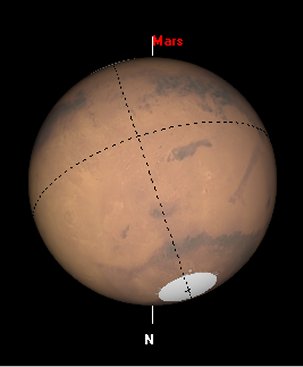
Figure 2. A simulated view of the appearance of Mars during opposition at 1947 UT on March 03, 2012 (78.1° Ls)
The observable disk diameter of Mars
will be greater than 6 arcsec from seconds November 04, 2011 [14.3°
d
] (24.7° Ls) and will not fall below this value until July 21, 2012
[-3.7° d
] (142.5° Ls), lasting more than 8 months or 118 degrees Ls. During
a similar profile in 2010 Mars began at 6 arcsec on September 8, 2009 [23.5°
d
] (334.8 ° Ls) and did not fall below this value until June 01, 2010
[13.9°
d
] (98.4° Ls), equaling nearly 9 months or 124 degrees Ls. Imaging by
CCD devices may begin with a disk diameter of 4 arcsec or less, commencing
on April 13, 2011.
During closest approach in 2012 the apparent diameter of Mars will be 0.21 arcsec smaller than it was at the same period in 2010 and it will be 12 degrees lower in the sky not great for observing the Red Planet.
The Sub-Earth (De) and Sub-Solar (Ds) points are graphically represented in Figures 3 and 4. The 2011 and 2012 Ephemeris of Mars is tabulated the following URL: http://www.tnni.net/~dustymars/eph11_12.html A glossary of Terms appears at the end of this table.
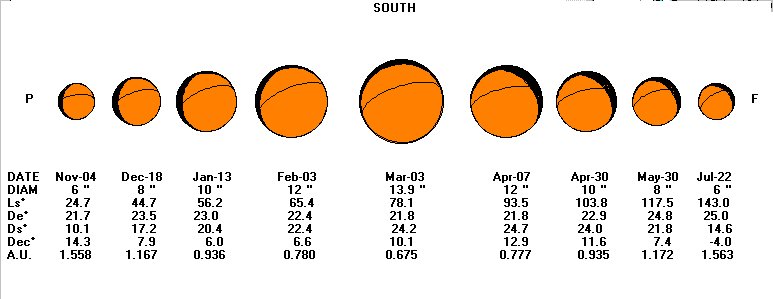
Figure 3. As it approaches Earth, it will swell from a small apparent disk of 6" in November 04, 2012 to a maximum diameter on March 03, 2012, and then shrink as it moves away. Closest approach occurs on March 05, 2012 (Opposition March 03, 2012). From November 2012 through July 2012 are the prime observing months.
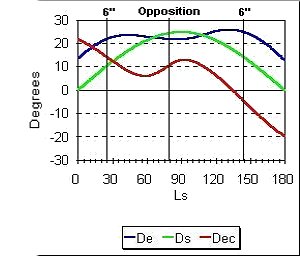
Figure 4. Graphic Ephemeris of Mars during the 2011-2012 apparition from September 14, 2011 through September 30, 2012. Opposition and 6 arcsec apparent diameter range arc indicated. Plot illustrates the Declination (blue line), the latitude of the Sub-Earth point (De) or the apparent tilt (green line) in areocentric degrees, and the latitude of the Sub-Solar point (red line) in areocentric degrees. The areocentric longitude (Ls) of the Sun, shown along the bottom edge of the graph defines the Martian seasonal date. The value of Ls is 0° at the vernal equinox of the northern hemisphere, 70° when Mars is at aphelion, and 90° at the summer solstice of the northern hemisphere 250° when Mars is at perihelion, and 180° is northern autumn.
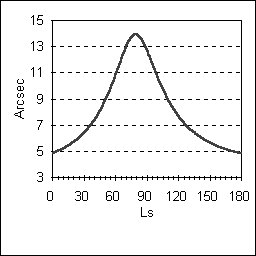
Figure 5. Graphic Ephemeris of Mars from September 14, 2011 through September 30, 2012. Plot illustrates the apparent diameter of Mars in seconds of arc. The areocentric longitude (Ls) of the Sun, shown along the bottom edge of the graph defines the Martian seasonal date.
The Martian North Polar
Region
Astronomers will have an excellent view of the prominent north polar cap during most of the next apparition because it will be tilted earthward during the last half of 2011 and through mid-November 2012. On July 26, 2011 the Martian North Polar Region (NPR) will begin to tilt towards the Earth and will remain so for the remainder of the apparition.
For those interested in catching a glimpse of possible "flashes" from the surface of Mars the first occasion when the De and Ds are coincident at 23.4° , will be on or about February 03, 2012 when Mars will be 12 arcsec in apparent diameter. The next period for possible flashes will be on or about May 09, 2012 when the De and Ds are coincident at 23.5° .
For more detailed information on the north
polar cap click to the URL:
http://www.tnni.net/~dustymars/NPR.htm
Table 2. CALENDAR OF EVENTS -- MARS, 2010
| DATE | PHYSICAL | REMARKS |
| 2011 Jan 20 | Ls 220.6° | Conjunction Ingress. Mars will disappear behind the limb of the Sun. |
| 2011 Feb 04 | Ls 229.9° | Conjunction. Mars is behind the Sun ~2.375 AU. |
| 2011 Feb 25 | Ls 243.2° | Conjunction Egress. Mars will emerge from behind the limb of the Sun. |
| 2011 Mar 08 | Ls 250.2°
De -24.6° Ds -23.2° RA 22:48 Dec -08.7° A.Dia 3.97 |
Mars at Perihelion. Late southern spring. SPC in rapid retreat. Novus Mons smaller. Dust clouds expected over Serpentis-Hellaspontus (Ls 250 - 270). Syrtis Major narrow. Frost in bright deserts? Orographic clouds (W-clouds) possible. Elysium and Arisa Mons bright? Frost in bright deserts? Novus Mons smaller. Note: Several "planet-encircling dust storms have been reported during this season. High probability 255° Ls. |
| 2011 Sep 14 | Ls 0°
De 13.5° Ds 0.1° RA 07:56 Dec 21.6° A.Dia 4.9 |
Equinox - Northern Autumn/Southern Spring. North Polar Hood (NPH) begins to break up. North Polar Cap (NPC) should be exposed at approximately 65° areographic latitude. ("Areo-" is a prefix often employed when referring to Mars or "Ares."). South Polar Cap (SPC) maximum diameter, subtending ~ 60.5° W. Does SPH or frost cover Hellas? Hellas should begin to clear and darken. Are W-clouds present? |
| 2011 Nov 04 | Ls 24.7°
De 21.7° Ds 10.1° RA 09:56 Dec 14.3° A.Dia 6 |
Apparition begins for observers using 4-inch to 8-inch apertures telescopes and up. Begin low-resolution CCD imaging. Views of surface details not well defined. NPC nearly static and begin erratic retreat, hood continues to dissipate. Orographic cloud over Apollinaris Petera? Windy season on Mars begins, dust clouds present? Watch for initial dust clouds in south. White patches in bright areas? Hellas bright spots? Numerous bright patches. (NPC W ~65°). |
| 2011 Dec 18 | Ls 44.7°
De 23.5° Ds 17.2° RA 11:12 Dec 7.9° A.Dia 8 |
North
Polar Hood (NPH) breaking up, North Polar Cap (NPC) should be exposed Hellas
and Argyre bright? Limb arcs increasing in frequency or intensity. Arctic
hazes and clouds present? (NPC W ~43.4°).
|
| 2012 Jan 13 | Ls 56.2°
De 23.0° Ds 20.4° RA 11:37 Dec 6.0° A.Dia 10 |
Watch for "Aphelic Chill" in NPR (usually between 60° and 70° Ls) and possible halt in thawing of NPC. Views of surface details well defined. Rima Tenuis may appear (140° and 320° areographic meridians). Cloud activity in north increasing? (NPC W ~44.5° ±1.0°). |
| 2012 Jan 25 | Ls 61.9°
De 22.6° Ds 21.7° RA 11:40 Dec 6.1° A.Dia 11.1 |
Retrogression
Begins. Mars begins retrogression, or retrograde motion against the
background stars nearly 3xx days after conjunction, when it appears to
move backwards toward the west for a brief period before, during and after
opposition. (NPC W ~44.5° ±1.0°).
|
| 2012 Feb 03 | Ls 65.4°
De 22.4° Ds 22.4° RA 11:38 Dec 6.6° A.Dia 12 |
Watch for "Aphelic Chill" in NPR (usually between 60° and 70° Ls) and possible halt in thawing of NPC. High-resolution CCD imaging and photography. |
| 2012 Feb 14 | Ls 70°
De 22.2° Ds 23.2° RA 11:30 Dec 7.6° A.Dia 13 |
Mars at Aphelion. Is North Cap fairly static or entering rapid retreat phase. Watch for "Aphelic Chill" in NPR (usually between 60° and 70° Ls). NPC Rima Tenuis may appear. Antarctic hazes, hood. South polar regions becoming difficult to observe. Any signs of SPH? Cloud activity increases. Are limb arcs increasing in frequency, intensity? (NPC W ~37.4° ±0.8°). |
| 2012 Mar 03 | Ls 78.1°
De 21.8° Ds 24.2° RA 11:07 Dec 10.1° A.Dia 13.9 |
Mars
at Opposition. NPC in rapid retreat? Are limb arcs increasing in frequency,
intensity. Antarctic hazes/hood. Cloud activity increases. "Aphelic Chill"
in NPR should be ended. (NPC W ~30.0° ±1.3°).
|
| 2012 Mar 05 | Ls 79.0°
De 21.7° Ds 24.3° RA 11:04 Dec 10.4° A.Dia 13.9 |
Mars
at Closest Approach. Few clouds. Limb arcs increasing in frequency
or intensity. Arctic hazes and clouds present.
(NPC W ~30.0° ±1.3°).
|
| 2012 Mar 30 | Ls 90°
De 21.6° Ds 24.8° RA 10:33 Dec 12.8° A.Dia 12.7 |
Solstice - Northern Summer/Southern Winter. Orographic clouds over the Tharsis volcanoes W-Cloud? Local seasonal clouds should wrap around Syrtis Major and be prominent in Lybia. Hellas white cloud and Ice-fog activity? Discrete clouds? NPC remnant? Lemuria (210° W, 82° N) detached from NPC? Any other detachments (projections at 135° W and 290° W) near NPC remnant? . (NPC W ~22.3° ±1.1°). |
| 2012 Apr 07 | Ls 93.5°
De 21.8° Ds 24.7° RA 10:28 Dec 12.9° A.Dia 12 |
Orographic
clouds over the Tharsis volcanoes W-Cloud? Local seasonal clouds should
wrap around Syrtis Major and be prominent in Lybia. Hellas white cloud
and Ice-fog activity? Discrete clouds? Rima Tenuis may appear (140°
and 320° areographic meridians. . (NPC W ~22.3° ±1.1°).
|
| 2012 Apr 16 | Ls 97.5°
De 22.1° Ds 24.6° RA 10:26 Dec 12.6° A.Dia 11.3 |
Retrogression
Ends. Mars begins westward motion against the background stars.
|
| 2012 Apr 30 | Ls 103.8°
De 22.9° Ds 24.0° RA 10:31 Dec 11.6° A.Dia 10 |
Is North Cap fairly static or entering rapid retreat phase. South polar regions becoming difficult to observe. Any signs of SPH? Discrete clouds? Increasing ice-fogs and clouds ? (NPC W ~19.3° ±0.4°). |
| 2012 May 30 | Ls 117.5°
De 24.8° Ds 21.8° RA 11:02 Dec 7.4° A.Dia 8 |
Is Mare Acidalium broad and dark? Bright spots in Tempe-Arcadia-Tharsis-Amazoins? "Domino effect" appears around 120 - 125° Ls. Topographic clouds increase. (NPC W ~16.7° ±0.3°). |
| 2012 Jul 22 | Ls 143.0°
De 25.0° Ds 14.6° RA 12:37 Dec -4.0° A.Dia 6 |
If both
polar caps are visible look for haze canopy? Clouds and frosts prominent
in north. Clouds area in south. Syrtis Major broad.
(NPC W ~13.9° ±0.9°).
|
| 2012 Sep 30 | Ls 180° | Equinox - Northern Autumn/Southern Spring. South Polar Cap (SPC) maximum diameter, subtending ~ 60.5° W. Is the North Polar Hood present. Does SPH or frost cover Hellas? Hellas should begin to clear and darken. Are W-clouds present? South cap emerges from darkness of Winter. SPH thinning and forms "Life Saver Effect." |
| 2013 Apr 01 | Ls 293° | Conjunction Ingress. Mars will disappear behind the limb of the Sun. |
| 2013 Apr 17 | Ls 302° | Conjunction. Mars is behind the Sun ~2.430AU. |